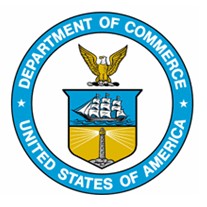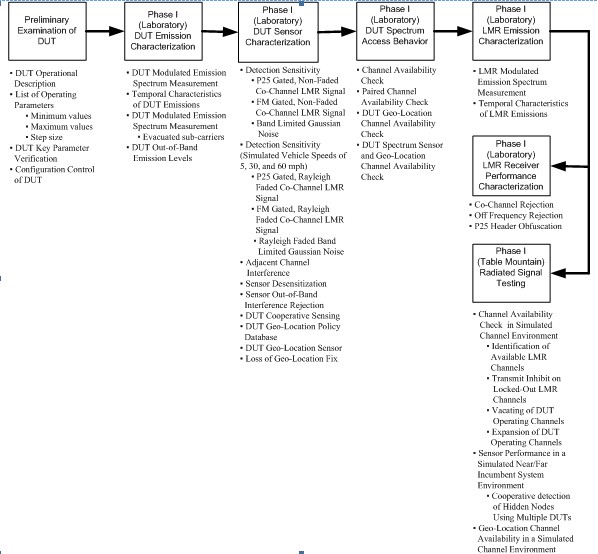Fiscal Year 2008 Progress Report
This progress report describes the activities related to the Spectrum Sharing Innovation Test-Bed Pilot Program undertaken during Fiscal Year 2008.
Spectrum Management
for the 21st Century
The President’s Spectrum Policy Initiative
Spectrum Sharing Innovation Test-Bed
Fiscal Year 2008 Progress Report

U.S. DEPARTMENT OF COMMERCE
CARLOS M. GUTIERREZ, SECRETARY
Meredith Attwell Baker, Acting Assistant Secretary for Communications and Information
November 2008
Table of Contents
I. BACKGROUND
II. DEVELOPMENT OF TEST-BED
III. SELECTION OF TEST-BED PARTICIPANTS
IV. DEVELOPMENT OF PHASE I TEST PLAN
V. PLANNED FISCAL YEAR 2009 ACTIVITIES
I. BACKGROUND
In May 2003, President Bush established the Spectrum Policy Initiative to promote the development and implementation of a United States spectrum policy for the 21st Century.[1] In response to the Spectrum Policy Initiative, the Secretary of Commerce established a Federal Government Spectrum Task Force and initiated a series of public meetings to address policies affecting spectrum use by the federal, state, and local governments, and the private sector. The recommendations resulting from these activities were included in two reports released by the Secretary of Commerce in June 2004.[2] Based on the recommendations contained in these reports, the President directed the federal agencies on November 30, 2004, to plan the implementation of the recommendations contained in the reports.[3]
One of these recommendations stated that the National Telecommunications and Information Administration (NTIA) and the Federal Communications Commission (FCC), in coordination with the federal agencies are to establish a Test-Bed to examine the feasibility of increased sharing between federal and non-federal users.[4] Specifically, the Test-Bed recommendation states:
Within two years of this report’s publication, NTIA and the FCC should establish a pilot program to allow for increased sharing between federal and non-federal users. NTIA and the FCC should each identify a segment of spectrum of equal bandwidth within their respective jurisdiction for this program. Each segment should be approximately 10 MHz for assignment on a shared basis for federal and non-federal use. The spectrum to be identified for this pilot program could come from bands currently allocated on either an exclusive or shared basis. Two years after the inception of the pilot program, NTIA and the FCC should provide reports outlining the results and suggesting appropriate procedures for expanding the program as appropriate.[5]
The recommendation to establish the Test-Bed recognized that the increased use of spectrum for federal and non-federal communications necessitates increased sharing to benefit both federal and non-federal users of the spectrum.
This progress report describes the activities related to the Test-Bed pilot program undertaken during Fiscal Year 2008.
II. DEVELOPMENT OF TEST-BED
On June 8, 2006, NTIA published a Notice of Inquiry (NOI) in the Federal Register seeking public comment on issues related to the Test-Bed.[6] The FCC also solicited public comment on issues related to the Test-Bed through a separate Public Notice (PN).[7] There were 14 comments filed in response to the NOI and 16 comments and 9 reply comments filed in response to the PN.[8]
The public comments filed in response to the NOI and PN were reviewed by the Commerce Spectrum Management Advisory Committee (CSMAC), which was established as part the Presidential Spectrum Policy Initiative to advise the Assistant Secretary of Commerce for Communications and Information, Department of Commerce, on needed reforms to spectrum policies and management to enable the introduction of new spectrum dependent technologies and services.[9] The CSMAC provided recommendations to NTIA in a December 6, 2007 report.[10] The CSMAC provided recommendations addressing: 1) the goal of the Test-Bed pilot program; 2) multiple Test-Beds; 3) funding for multiple Test-Beds; 4) maximization of participants; 5) protection of incumbents; 6) Test-Bed location; and 7) public reports. These recommendations were consistent with NTIA’s proposed implementation of the Test-Bed Pilot Program and did not require modification of NTIA’s existing plans for that program.
NTIA also sought comments from federal agency subject matter experts and the members of the Interdepartment Radio Advisory Committee (IRAC).[11]
The public responses to the NTIA NOI and FCC PN as well as the comments provided by the CSMAC and the federal agencies were used to develop the Test-Bed pilot program.
On February 5, 2008 NTIA published a Notice in the Federal Register describing the Test-Bed pilot program.[12] Concurrently, the FCC released a Public Notice designating 10 MHz of non-federal spectrum to be used in the Test-Bed pilot program and providing guidance for participants.[13] As described in these notices, the Test-Bed pilot program will evaluate the ability of Dynamic Spectrum Access (DSA) devices employing spectrum sensing and/or geo-location techniques to share spectrum with land mobile radio (LMR) systems operating in the 410-420 MHz Federal band and in the 470-512 MHz non-Federal band.[14] To address potential interference to incumbent spectrum users the Test-Bed pilot program will include both laboratory and field measurements performed in three phases:
Phase I – Equipment Characterization. Equipment employing DSA techniques will be sent to the NTIA Institute for Telecommunication Sciences in Boulder, Colorado to undergo characterization measurements of the DSA capabilities in response to simulated environmental signals.
Phase II – Evaluation of Capabilities. After completion of Phase I, the DSA spectrum sensing and/or geo-location capabilities of the equipment will be evaluated in the geographic area of the Test-Bed.
Phase III – Field Operation Evaluation. After completion of Phase II the DSA equipment will be permitted to transmit in an actual radio frequency signal environment. An automatic signal logging capability will be used during operation of the Test-Bed to help resolve interference events if they occur. A point-of-contact will also be established to stop Test-Bed operations if interference is reported.
Only after successful completion of a phase will a device be considered under the subsequent phases of the Test-Bed.
III.SELECTION OF TEST-BED PARTICIPANTS
The February 5, 2008, Federal Register Notice also sought expressions of interest from parties that wanted to participate in the Test-Bed. The following criteria were used to evaluate the solicitations to participate in the Test-Bed pilot program:
▪ How well does the proposed technology achieve the goal of the Test-Bed?
▪ How readily available is the equipment proposed for the Test-Bed?
▪ How well does the proposed technology explore creative and original concepts in spectrum sharing?
▪ For the proposed technology, can the results of the Test-Bed be disseminated broadly to enhance scientific and technologic understanding?
▪ How well does the proposed technology address the potential impact on the incumbent spectrum user(s)?
▪ Can the proposed technology be adapted for a variety of services and applications, including broadband, military/homeland security, and public safety?
▪ Are there any technical factors that limit the proposed technology to a specific frequency range?
▪ Will the necessary technical support be provided to assure performance of the equipment during the Test-Bed?
Eleven parties submitted solicitations of interest to participate in the Test-Bed pilot program. In June 2008 the following parties were notified they had met the selection criteria:[15]
Adapt4 LLC;
Adaptrum Inc.;
BAE Systems;
Motorola Inc.;
Shared Spectrum Company; and
Virginia Polytechnic Institute and State University.
IV. DEVELOPMENT OF PHASE I TEST PLAN
During June 2008, NTIA, working in conjunction with the federal agencies and the FCC developed technical questions and proposed test cases to be performed under Phase I. The technical questions and proposed test cases were used to develop the test plan the Phase I.
The Phase I test cases for each DSA Device Under Test (DUT) are broken down into five categories: DUT emission characterization, DUT sensor characterization, DUT spectrum access behavior, LMR emission characterization, and LMR receiver performance characterization. An overview of the proposed test cases to be performed under Phase I are shown in Figure 1. The proposed test cases shown in Figure 1 describe the types and depth of testing that NTIA intends to conduct in Phase I to assess whether devices employing DSA spectrum sensing and/or geo-location techniques can share the frequency spectrum with LMR systems.

Figure 1.
During the July-September 2008 timeframe, individual meetings were held with the Test-Bed participants to discuss their DSA devices in more detail. Based on these meetings NTIA working with the federal agencies and the FCC developed a test plan for Phase I. The Phase I test plan has been coordinated with the federal agencies on the IRAC and is being coordinated with the Test-Bed participants.
V. PLANNED FISCAL YEAR 2009 ACTIVITIES
The coordination of the Phase I test plan with the Test-Bed participants will be completed. The coordinated Phase I test plan will be published in the Federal Register for public review and comment. The public comments on the test plan will be addressed and a final version published on the NTIA website.
Testing of the first DSA device will begin in January 2009. NTIA estimates it will take three to four months to complete the testing for each DSA device. After coordinating the test results with the Test-Bed participants, NTIA will draft and coordinate with the federal agencies on the IRAC, a report documenting the results. The report will be published in the Federal Register for public review and comment.
NTIA will also begin developing a test plan for Phase II and III that will be coordinated with the federal agencies, Test-Bed participants, and the public.
[1]. Presidential Memorandum on Spectrum Policy for the 21st Century, 69 Fed. Reg. 1568 (Jan. 9, 2004), 39 Weekly Comp. Pres. Doc. 726, 727 (May 29, 2003), available at http://www.whitehouse.gov/news/releases/2003/06/20030605-4.html.
[2]. Department of Commerce, Spectrum Policy for the 21st Century – The President’s Spectrum Policy Initiative: Report 1 Recommendations of the Federal Government Spectrum Task Force (June 2004) (“Report 1”); Department of Commerce, Spectrum Policy for the 21st Century - The President’s Spectrum Policy Initiative: Report 2 Recommendations From State and Local Governments and Private Sector Responders (June 2004) (“Report 2”). These reports are available at http://www.ntia.doc.gov/reports/.
[3]. President’s Memorandum on Improving Spectrum Management for the 21st Century, 49 Weekly Comp. Pres. Doc. 2875 (November 29, 2004).
[4]. By this Notice, NTIA is implementing its responsibilities under the President’s November 2004 Executive Memorandum. The FCC is also designating spectrum and establishing procedures for the Test-Bed through a public notice. Public Notice, Federal Communications Commission Designates Spectrum and Provides Guidance for Participation in a Spectrum Sharing Innovation Test-Bed, ET Docket No. 06-89.
[5]. Report 1, supra note 2, Recommendation 11; Report 2, supra note 2, Recommendation 6(b).
[6]. National Telecommunications and Information Administration, Docket, No. 060602142-6142-01, Notice of Inquiry, 71 Fed. Reg. 33282 (June 8, 2006).
[7]. Federal Communications Commission, ET Doc. No. 06-89, FCC 06-77, Creation of a Spectrum Sharing Innovation Test-Bed, 71 Fed. Reg. 35675 (June 21, 2006).
[8]. The public comments filed in response to the NOI are available at http://www.ntia.doc.gov/ntiahome/frnotices/2006/spectrumshare/comments.htm
The public comments and reply comments filed in response to the public notice are available on the FCC Electronic Comment Filing System (ET Docket No. 06-89).
[9]. Information regarding the CSMAC is available at http://www.ntia.doc.gov/advisory/spectrum/.
[10]. CSMAC Report: Opportunities Relating to the Spectrum Sharing Test Bed, available at http://www.ntia.doc.gov/osmhome/reports/2007/CSMAC_TestBed_Report.pdf.
[11]. The IRAC, consisting of representatives of 20 federal agencies, serves in an advisory capacity to the Assistant Secretary of Commerce for Communications and Information. The IRAC assists the Assistant Secretary in the discharge of his responsibilities pertaining to the use of the electromagnetic spectrum.
[12]. National Telecommunications and Information Administration, Docket No. 080129095-8096-01, 73 FR 6710 (February 5, 2008).
[13]. See Federal Communications Commission Designates Spectrum and Provides Guidance For Participation In a Spectrum Sharing Innovation Test-Bed, ET Docket No. 06-89, Public Notice, FCC 08-295 (rel. February 5, 2008).
[14]. Dynamic Spectrum Access technology allows a radio device to (i) evaluate its radio frequency environment using spectrum sensing, geo-location, or a combination of spectrum sensing and geo-location techniques, (ii) determine which frequencies are available for use on a non-interference basis, and (iii) reconfigure itself to operate on the identified frequencies.
[15]. A list of the participants and additional information on the Test-Bed pilot program is available on the NTIA website http://www.ntia.doc.gov/ntiahome/frnotices/2006/spectrumshare/comments.htm.
